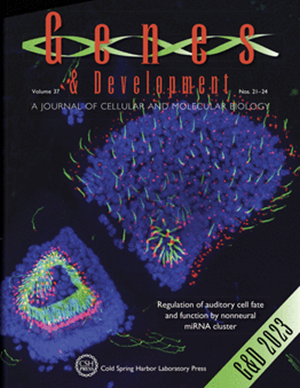A feedback amplifier circuit with Notch and E2A orchestrates T-cell fate and suppresses the innate lymphoid cell lineages during thymic ontogeny
IF 7.7
1区 生物学
Q1 CELL BIOLOGY
引用次数: 0
Abstract
External signals from the thymic microenvironment and the activities of lineage-specific transcription factors (TFs) instruct T-cell versus innate lymphoid cell (ILC) fates. However, mechanistic insights into how factors such as Notch1–Delta-like-4 (Dll4) signaling and E-protein TFs collaborate to establish T-cell identity remain rudimentary. Using multiple in vivo approaches and single-cell multiome analysis, we identified a feedback amplifier circuit that specifies fetal and adult T-cell fates. In early T progenitors (ETPs) in the fetal thymus, Notch signaling minimally lowered E-protein antagonist Id2 levels, and high Id2 abundance favored the differentiation of ETPs into ILCs. Conversely, in the adult thymus, Notch signaling markedly decreased Id2 abundance in ETPs, substantially elevating E-protein DNA binding and in turn promoting the activation of a T-cell lineage-specific gene expression program linked with V(D)J gene recombination and T-cell receptor signaling. Our findings indicate that, in the fetal versus the adult thymus, a simple feedback amplifier circuit dictated by Notch-mediated signals and Id2 abundance enforces T-cell identity and suppresses ILC development.一个带有Notch和E2A的反馈放大电路在胸腺个体发生过程中协调t细胞的命运并抑制先天淋巴样细胞谱系
来自胸腺微环境的外部信号和谱系特异性转录因子(TFs)的活性指导t细胞与先天淋巴样细胞(ILC)的命运。然而,诸如Notch1-Delta-like-4 (Dll4)信号传导和e蛋白TFs等因子如何协同建立t细胞身份的机制见解仍处于初级阶段。使用多种体内方法和单细胞多组分析,我们确定了一个反馈放大电路,指定胎儿和成人t细胞的命运。在胎儿胸腺的早期T祖细胞(ETPs)中,Notch信号可以最低限度地降低e蛋白拮抗剂Id2的水平,而高Id2丰度有利于ETPs向ILCs的分化。相反,在成年胸腺中,Notch信号显著降低了etp中Id2的丰度,显著提高了e蛋白DNA结合,进而促进了与V(D)J基因重组和t细胞受体信号传导相关的t细胞谱系特异性基因表达程序的激活。我们的研究结果表明,在胎儿胸腺和成人胸腺中,一个由notch介导的信号和Id2丰度决定的简单反馈放大电路增强了t细胞的身份并抑制了ILC的发育。
本文章由计算机程序翻译,如有差异,请以英文原文为准。
求助全文
约1分钟内获得全文
求助全文
来源期刊

Genes & development
生物-发育生物学
CiteScore
17.50
自引率
1.90%
发文量
71
审稿时长
3-6 weeks
期刊介绍:
Genes & Development is a research journal published in association with The Genetics Society. It publishes high-quality research papers in the areas of molecular biology, molecular genetics, and related fields. The journal features various research formats including Research papers, short Research Communications, and Resource/Methodology papers.
Genes & Development has gained recognition and is considered as one of the Top Five Research Journals in the field of Molecular Biology and Genetics. It has an impressive Impact Factor of 12.89. The journal is ranked #2 among Developmental Biology research journals, #5 in Genetics and Heredity, and is among the Top 20 in Cell Biology (according to ISI Journal Citation Reports®, 2021).
 求助内容:
求助内容: 应助结果提醒方式:
应助结果提醒方式:


